Go map實現原理 - 戀戀美食的個人空間 - OSCHINA - 中文開源技術交流社區 https://my.oschina.net/renhc/blog/2208417
// A header for a Go map.
type hmap struct {
// Note: the format of the hmap is also encoded in cmd/compile/internal/gc/reflect.go.
// Make sure this stays in sync with the compiler's definition.
count int // # live cells == size of map. Must be first (used by len() builtin)
flags uint8
B uint8 // log_2 of # of buckets (can hold up to loadFactor * 2^B items)
noverflow uint16 // approximate number of overflow buckets; see incrnoverflow for details
hash0 uint32 // hash seed
buckets unsafe.Pointer // array of 2^B Buckets. may be nil if count==0.
oldbuckets unsafe.Pointer // previous bucket array of half the size, non-nil only when growing
nevacuate uintptr // progress counter for evacuation (buckets less than this have been evacuated)
extra *mapextra // optional fields
}
Golang的map使用哈希表作為底層實現,一個哈希表里可以有多個哈希表節點,也即bucket,而每個bucket就保存了map中的一個或一組鍵值對。
map數據結構由runtime/map.go:hmap定義:
type hmapstruct{
countint//當前保存的元素個數
...
B???????? uint8
...
bucketsunsafe.Pointer// bucket數組指針,數組的大小為2^B
...
}
下圖展示一個擁有4個bucket的map:
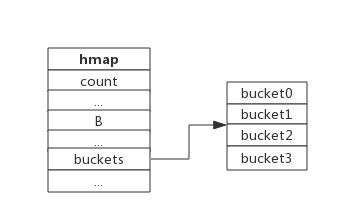
本例中,?hmap.B=2, 而hmap.buckets長度是2^B為4. 元素經過哈希運算后會落到某個bucket中進行存儲。查找過程類似。
bucket很多時候被翻譯為桶,所謂的哈希桶實際上就是bucket。
2. bucket數據結構
bucket數據結構由runtime/map.go:bmap定義:
type bmapstruct{
tophash [8]uint8//存儲哈希值的高8位
databyte[1]//key value數據:key/key/key/.../value/value/value...
overflow *bmap//溢出bucket的地址
}
每個bucket可以存儲8個鍵值對。
tophash是個長度為8的數組,哈希值相同的鍵(準確的說是哈希值低位相同的鍵)存入當前bucket時會將哈希值的高位存儲在該數組中,以方便后續匹配。
data區存放的是key-value數據,存放順序是key/key/key/…value/value/value,如此存放是為了節省字節對齊帶來的空間浪費。
overflow 指針指向的是下一個bucket,據此將所有沖突的鍵連接起來。
注意:上述中data和overflow并不是在結構體中顯示定義的,而是直接通過指針運算進行訪問的。
下圖展示bucket存放8個key-value對:
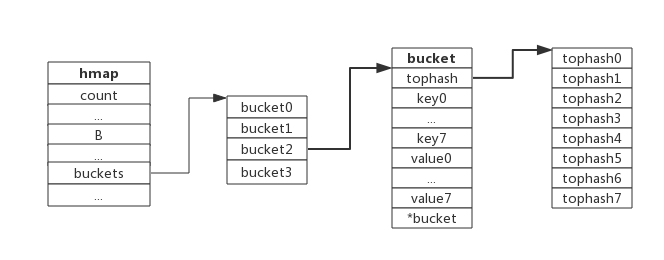
package runtime
// This file contains the implementation of Go's map type.
//
// A map is just a hash table. The data is arranged
// into an array of buckets. Each bucket contains up to
// 8 key/elem pairs. The low-order bits of the hash are
// used to select a bucket. Each bucket contains a few
// high-order bits of each hash to distinguish the entries
// within a single bucket.
//
// If more than 8 keys hash to a bucket, we chain on
// extra buckets.
//
// When the hashtable grows, we allocate a new array
// of buckets twice as big. Buckets are incrementally
// copied from the old bucket array to the new bucket array.
//
// Map iterators walk through the array of buckets and
// return the keys in walk order (bucket #, then overflow
// chain order, then bucket index). To maintain iteration
// semantics, we never move keys within their bucket (if
// we did, keys might be returned 0 or 2 times). When
// growing the table, iterators remain iterating through the
// old table and must check the new table if the bucket
// they are iterating through has been moved ("evacuated")
// to the new table.
// Picking loadFactor: too large and we have lots of overflow
// buckets, too small and we waste a lot of space. I wrote
// a simple program to check some stats for different loads:
// (64-bit, 8 byte keys and elems)
// loadFactor %overflow bytes/entry hitprobe missprobe
// 4.00 2.13 20.77 3.00 4.00
// 4.50 4.05 17.30 3.25 4.50
// 5.00 6.85 14.77 3.50 5.00
// 5.50 10.55 12.94 3.75 5.50
// 6.00 15.27 11.67 4.00 6.00
// 6.50 20.90 10.79 4.25 6.50
// 7.00 27.14 10.15 4.50 7.00
// 7.50 34.03 9.73 4.75 7.50
// 8.00 41.10 9.40 5.00 8.00
//
// %overflow = percentage of buckets which have an overflow bucket
// bytes/entry = overhead bytes used per key/elem pair
// hitprobe = # of entries to check when looking up a present key
// missprobe = # of entries to check when looking up an absent key
//
// Keep in mind this data is for maximally loaded tables, i.e. just
// before the table grows. Typical tables will be somewhat less loaded.
import (
"runtime/internal/atomic"
"runtime/internal/math"
"runtime/internal/sys"
"unsafe"
)
const (
// Maximum number of key/elem pairs a bucket can hold.
bucketCntBits = 3
bucketCnt = 1 << bucketCntBits
// Maximum average load of a bucket that triggers growth is 6.5.
// Represent as loadFactorNum/loadFactorDen, to allow integer math.
loadFactorNum = 13
loadFactorDen = 2
// Maximum key or elem size to keep inline (instead of mallocing per element).
// Must fit in a uint8.
// Fast versions cannot handle big elems - the cutoff size for
// fast versions in cmd/compile/internal/gc/walk.go must be at most this elem.
maxKeySize = 128
maxElemSize = 128
// data offset should be the size of the bmap struct, but needs to be
// aligned correctly. For amd64p32 this means 64-bit alignment
// even though pointers are 32 bit.
dataOffset = unsafe.Offsetof(struct {
b bmap
v int64
}{}.v)
// Possible tophash values. We reserve a few possibilities for special marks.
// Each bucket (including its overflow buckets, if any) will have either all or none of its
// entries in the evacuated* states (except during the evacuate() method, which only happens
// during map writes and thus no one else can observe the map during that time).
emptyRest = 0 // this cell is empty, and there are no more non-empty cells at higher indexes or overflows.
emptyOne = 1 // this cell is empty
evacuatedX = 2 // key/elem is valid. Entry has been evacuated to first half of larger table.
evacuatedY = 3 // same as above, but evacuated to second half of larger table.
evacuatedEmpty = 4 // cell is empty, bucket is evacuated.
minTopHash = 5 // minimum tophash for a normal filled cell.
// flags
iterator = 1 // there may be an iterator using buckets
oldIterator = 2 // there may be an iterator using oldbuckets
hashWriting = 4 // a goroutine is writing to the map
sameSizeGrow = 8 // the current map growth is to a new map of the same size
// sentinel bucket ID for iterator checks
noCheck = 1<
)
3. 哈希沖突
當有兩個或以上數量的鍵被哈希到了同一個bucket時,我們稱這些鍵發生了沖突。Go使用鏈地址法來解決鍵沖突。由于每個bucket可以存放8個鍵值對,所以同一個bucket存放超過8個鍵值對時就會再創建一個鍵值對,用類似鏈表的方式將bucket連接起來。
下圖展示產生沖突后的map:
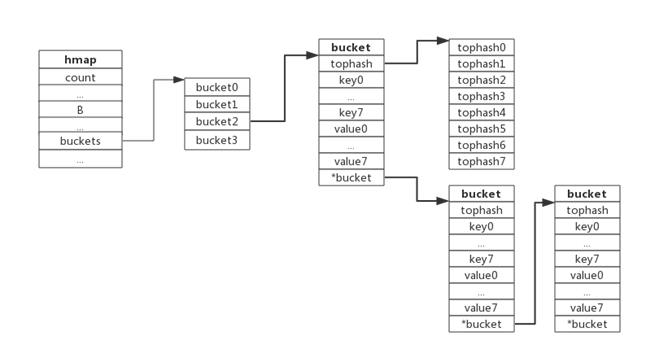
bucket數據結構指示下一個bucket的指針稱為overflow bucket,意為當前bucket盛不下而溢出的部分。事實上哈希沖突并不是好事情,它降低了存取效率,好的哈希算法可以保證哈希值的隨機性,但沖突過多也是要控制的,后面會再詳細介紹。
4. 負載因子
負載因子用于衡量一個哈希表沖突情況,公式為:
負載因子 = 鍵數量/bucket數量
例如,對于一個bucket數量為4,包含4個鍵值對的哈希表來說,這個哈希表的負載因子為1.
哈希表需要將負載因子控制在合適的大小,超過其閥值需要進行rehash,也即鍵值對重新組織:
哈希因子過小,說明空間利用率低
哈希因子過大,說明沖突嚴重,存取效率低
每個哈希表的實現對負載因子容忍程度不同,比如Redis實現中負載因子大于1時就會觸發rehash,而Go則在在負載因子達到6.5時才會觸發rehash,因為Redis的每個bucket只能存1個鍵值對,而Go的bucket可能存8個鍵值對,所以Go可以容忍更高的負載因子。
5. 漸進式擴容
5.1 擴容的前提條件
為了保證訪問效率,當新元素將要添加進map時,都會檢查是否需要擴容,擴容實際上是以空間換時間的手段。
觸發擴容的條件有二個:
1.????? 負載因子 > 6.5時,也即平均每個bucket存儲的鍵值對達到6.5個。
2.????? overflow數量 > 2^15時,也即overflow數量超過32768時。
5.2 增量擴容
當負載因子過大時,就新建一個bucket,新的bucket長度是原來的2倍,然后舊bucket數據搬遷到新的bucket。
考慮到如果map存儲了數以億計的key-value,一次性搬遷將會造成比較大的延時,Go采用逐步搬遷策略,即每次訪問map時都會觸發一次搬遷,每次搬遷2個鍵值對。
下圖展示了包含一個bucket滿載的map(為了描述方便,圖中bucket省略了value區域):
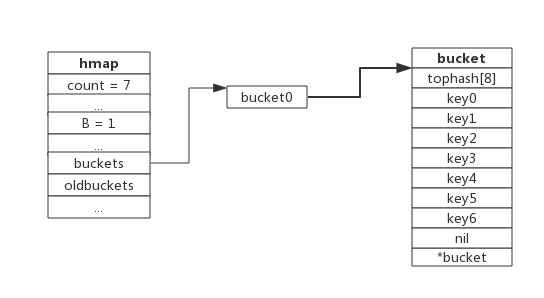
當前map存儲了7個鍵值對,只有1個bucket。此地負載因子為7。再次插入數據時將會觸發擴容操作,擴容之后再將新插入鍵寫入新的bucket。
當第8個鍵值對插入時,將會觸發擴容,擴容后示意圖如下:
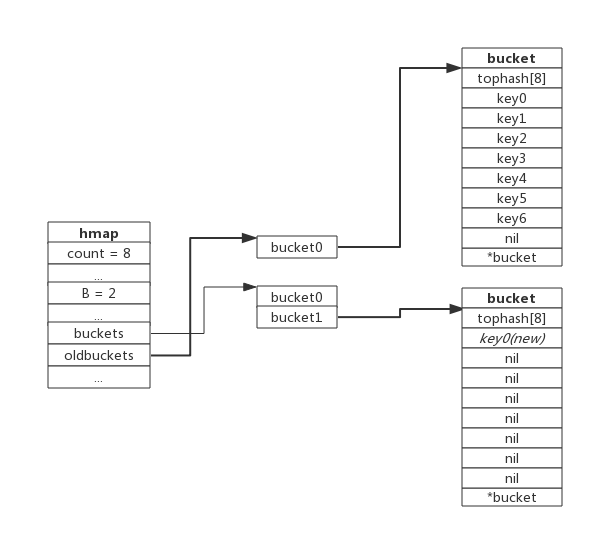
hmap數據結構中oldbuckets成員指身原bucket,而buckets指向了新申請的bucket。新的鍵值對被插入新的bucket中。后續對map的訪問操作會觸發遷移,將oldbuckets中的鍵值對逐步的搬遷過來。當oldbuckets中的鍵值對全部搬遷完畢后,刪除oldbuckets。
搬遷完成后的示意圖如下:
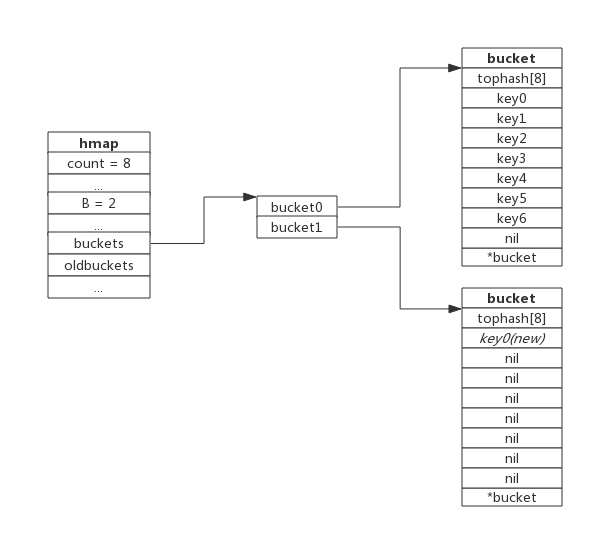
數據搬遷過程中原bucket中的鍵值對將存在于新bucket的前面,新插入的鍵值對將存在于新bucket的后面。實際搬遷過程中比較復雜,將在后續源碼分析中詳細介紹。
5.3 等量擴容
所謂等量擴容,實際上并不是擴大容量,buckets數量不變,重新做一遍類似增量擴容的搬遷動作,把松散的鍵值對重新排列一次,以使bucket的使用率更高,進而保證更快的存取。在極端場景下,比如不斷地增刪,而鍵值對正好集中在一小部分的bucket,這樣會造成overflow的bucket數量增多,但負載因子又不高,從而無法執行增量搬遷的情況,如下圖所示:
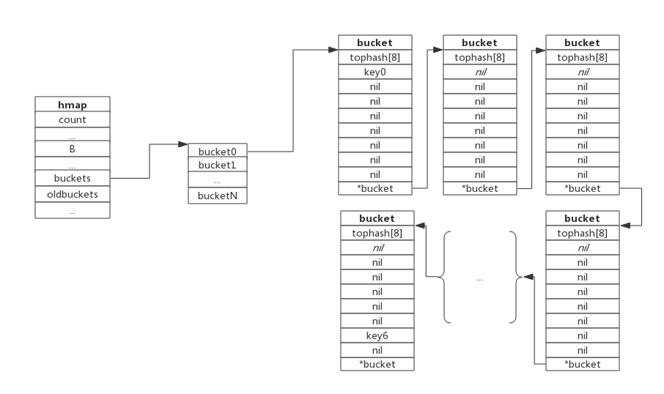
上圖可見,overflow的bucket中大部分是空的,訪問效率會很差。此時進行一次等量擴容,即buckets數量不變,經過重新組織后overflow的bucket數量會減少,即節省了空間又會提高訪問效率。
6. 查找過程
查找過程如下:
1.????? 根據key值算出哈希值
2.????? 取哈希值低位與hmap.B取模確定bucket位置
3.????? 取哈希值高位在tophash數組中查詢
4.????? 如果tophash[i]中存儲值也哈希值相等,則去找到該bucket中的key值進行比較
5.????? 當前bucket沒有找到,則繼續從下個overflow的bucket中查找。
6.????? 如果當前處于搬遷過程,則優先從oldbuckets查找
注:如果查找不到,也不會返回空值,而是返回相應類型的0值。
7. 插入過程
新元素插入過程如下:
1.????? 根據key值算出哈希值
2.????? 取哈希值低位與hmap.B取模確定bucket位置
3.????? 查找該key是否已經存在,如果存在則直接更新值
4.????? 如果沒找到將key,將key插入

)


:數據集標注與制作)













:容器)
面試大總結之一:Java搞定面試中的鏈表題目)